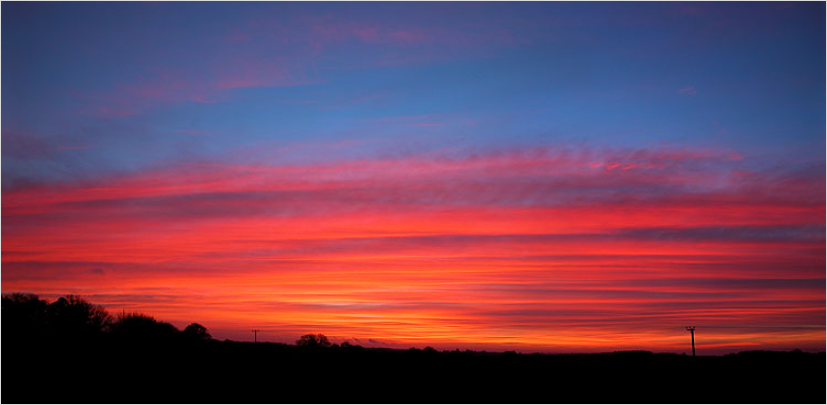Twilight sky
Twilight Sky: A Kaleidoscope of Colors
Have you ever gazed up at the sky during twilight and marveled at its stunning beauty? The twilight sky, with its vibrant hues and ethereal glow, is a sight to behold. In this article, we will delve into the fascinating phenomenon of the twilight sky and explore the science behind its mesmerizing colors.
Understanding the Science
One might wonder why the clear sky during twilight is not violet, given that shorter wavelengths are scattered more efficiently than longer ones. The answer lies in the composition of sunlight and the sensitivity of our eyes. While sunlight does contain some violet light, it is not as abundant as blue light. Additionally, our eyes are less sensitive to violet light, which contributes to the perception of a blue sky during daylight hours.
The Magic of Twilight
Twilight is a transitional period between day and night when the Sun is below the horizon but still illuminates the sky. It occurs in two stages: civil twilight and nautical twilight. During civil twilight, which happens just after sunset or before sunrise, there is still enough natural light for most outdoor activities. Nautical twilight follows civil twilight and is characterized by a darker sky with fewer visible stars.
Colors of Twilight
The colors that grace the twilight sky are a result of a phenomenon called Rayleigh scattering. This scattering occurs when sunlight interacts with molecules and tiny particles in the Earth's atmosphere. As sunlight passes through the atmosphere, it scatters in all directions. However, shorter wavelengths, such as blue and violet, are scattered more easily than longer wavelengths like red and orange.
During twilight, the angle at which sunlight passes through the atmosphere changes, leading to a unique interplay of colors. The lower the Sun is below the horizon, the more red and orange hues dominate the sky. This is because the longer wavelengths have a higher chance of reaching our eyes while shorter wavelengths are scattered away.
The Magic Hour
Twilight is often referred to as the "magic hour" by photographers and cinematographers. This is due to the enchanting quality of light during this time, which adds a dreamlike atmosphere to photographs and films. The soft, warm tones and long shadows create a captivating visual aesthetic that is sought after in various artistic mediums.
Twilight and Atmospheric Optics
The study of atmospheric optics provides valuable insights into the phenomena observed during twilight. Atmospheric optics encompasses a range of optical phenomena caused by the interaction of sunlight with the Earth's atmosphere. From the scattering of light to the formation of rainbows and halos, understanding atmospheric optics helps unravel the mysteries behind the breathtaking displays witnessed during twilight.
Capturing the Beauty
Photographers often seize the opportunity to capture the awe-inspiring beauty of the twilight sky. With the right camera settings and composition, they can immortalize the kaleidoscope of colors that paint the horizon during this magical time. Long exposures can reveal intricate details, while multiple exposures can showcase the gradual transformation of colors as twilight progresses.
The Significance of Twilight
Beyond its visual appeal, twilight holds cultural and symbolic significance in various societies. It is a time associated with transitions, reflection, and introspection. Twilight has inspired countless poems, artworks, and literary works, evoking a sense of wonder and contemplation. Its fleeting nature reminds us of the impermanence of life and the ever-changing beauty that surrounds us.
Embrace the Twilight
The twilight sky is a testament to the wonders of our natural world. It serves as a reminder that even in the transition from day to night, there is beauty to behold. So, next time you find yourself witnessing the spectacle of a colorful twilight sky, take a moment to immerse yourself in its magic and appreciate the breathtaking artistry painted across the heavens.

Twilight Sky. I've been asked "was it really that bright and colourful?" ~ Yes it was!
If the air scatters shorter wavelengths more efficiently than longer ones, why is clear sky not violet rather than blue? It appears so because sunlight does not contain much violet and the eye is not very sensitive to it.
Jan 26th 2003, sun's centre 3° below the horizon.
1/30s f/2.8 100 ISO equiv. 2 images each 35mm efl. Approximate FOV 75°
Photo ©2003 Les Cowley
Note: this article has been automatically converted from the old site and may not appear as intended. You can find the original article here.
Reference Atmospheric Optics
If you use any of the definitions, information, or data presented on Atmospheric Optics, please copy the link or reference below to properly credit us as the reference source. Thank you!
-
<a href="https://atoptics.co.uk/blog/twilight-sky/">Twilight sky</a>
-
"Twilight sky". Atmospheric Optics. Accessed on November 26, 2024. https://atoptics.co.uk/blog/twilight-sky/.
-
"Twilight sky". Atmospheric Optics, https://atoptics.co.uk/blog/twilight-sky/. Accessed 26 November, 2024
-
Twilight sky. Atmospheric Optics. Retrieved from https://atoptics.co.uk/blog/twilight-sky/.